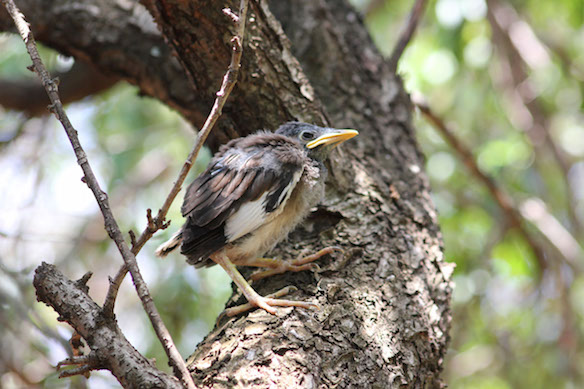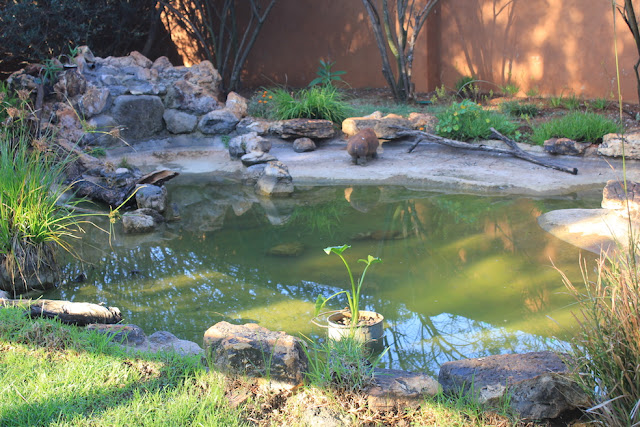This time of the year (winter) it is very difficult to distinguish between who is male and who is female with these abundant Southern Masked Weavers in my garden. In summer the male's bright yellow and black plumage is quite unmistakable, but now only their demeanour can give me a clue as to who's who.
The upright stance of these two birds clearly indicates they are males. Just moments before, another male tried to join the group at the feeding station and after a short scuffle, these two made it quite clear that he is not welcome!
Above is a Black-throated Canary
(Crithagra atrogularis) having a hard time finding space on the bird feeder. These sometimes inconspicuous canaries have a wonderful "tweet-sweet" call which always draws me out to the garden to see if I can get a pic, but they are very skittish.
A group discussion about what's available for breakfast!
Now, is that edible or not...?
A female (I presume!) Southern Masked Weaver inspecting what's on offer.
These weavers occur across southern Africa even in arid areas, extending
into Angola, Zambia and Malawi. It generally favours semi-arid scrub, open Savannah, woodland edges, riverine thicket, farmland with scattered trees, alien
tree plantations and gardens.
These birds are greatly preyed upon by the Ovambo
sparrowhawk, Little
sparrowhawk, Peregrine falcon and Lanner falcon. The eggs and chicks are in danger from the Boomslang, Common fiscal shrike, African grey hornbill and Vervet monkeys. Yet these gregarious birds continue to thrive and their conservation status is LC (least concern).
It mainly eats seeds, fruit (yet I've never seen them show any interest in the fruit I put out, maybe they prefer only certain berries), insects and nectar, doing most
of its foraging in small flocks, gleaning prey from leaves and branches, taking
seeds from the ground and grass stems. They love Cosmos flower seeds and are also partial to seeds of elms. Recorded fruits are from
.
- Rhus pyroides (Common currant)
- Prunus (Satsuma plum)
- Viscum rotundifolium (mistletoe)
- Ehretia rigida (Puzzle-bush)
.
They also eat the flower parts of
Prunus (peaches and apricots)
, Rhigozum trichotomum (Driedoring) and
Tagetes erecta (African marigold). They love the nectar from
.
- Aloe marlothii (Mountain aloe)
- Tecoma capensis (Cape honeysuckle)
- Schotia brachypetala (Weeping boer-bean)
- Eucalyptus sideroxylon (Red ironbark)
- Hibiscus rose-sinensis (hibiscus)
.
They love insects such as Coleoptera
(beetles and their larvae), termites, Ephemeroptera (mayflies) and caterpillars (larval stage of
Lepidoptera). They are also partial to human food like bread and porridge.
However, distinguishing between the sexes can be made as follows : The adult male in breeding plumage has a black face, throat and beak,
red eye, bright yellow head and underparts, and a plain yellowish-green
back. The female has a pinkish-brown bill, brown or red-brown eye and is
dull greenish-yellow, streaked darker on the upper back. The throat is
yellowish, fading to off-white on the belly. The non-breeding male
resembles the female but retains the red eye. The juvenile of this
species is like the female.
These birds are polygynous, as males may mate with up to about 12 females in a single
breeding season, living in colonies with 1-9 males in total, while each
female may often rear multiple broods per breeding season. It is much less
aggressive in comparison to most other weavers, although it viciously
attacks Diederick cuckoos
if they enter its territory.
Now, in winter, the nests are all empty and abandoned.
The nest is built solely by the male, consisting of a
kidney-shaped structure with a large entrance on the bottom, made of woven
grass, palm leaves or reeds with a ceiling of leaves, such as
Acacia
and
Eucalyptus. If the female accepts the nest she lines the interior
with leaves, grass inflorescences and feathers.
Egg-laying season is from July-March, peaking from September-February. She lays 1-6, usually 2-4 eggs, which are incubated solely by the female
for about 12-14 days. The chicks are fed by the female only on a diet of soft insect larvae
and grasshoppers, leaving the nest after about 16-17 days.
.
Every summer I stand watching the African Masked Weavers building their nests in my garden and it’s a hive of activity! Usually there are at least ten of them, with great squabbling going on in
between building sessions. This guy seems to be saying, “Rome wasn’t
built in a day, you know!” I stand amazed at the symmetry and perfection
of their work.
.










































